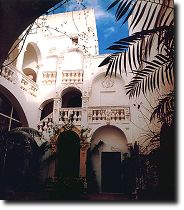 City of Salve
City of SalveFarms
The hills of the inland just as those near the sea are studded with many small and large
farms, some historically important, which in most cases were fortified with a tower for
defence against the Turk pirates in XVI.
Amongst those to visit Pali farm, Don Cesare farm, l'Aparo Valentini, the farm of the Fani,
Borgin farm and the farm of St. Lasi with its characteristic cylindrical tower and the
chapel dedicated to this saint (built on the ruins of a Byzantine church with tuffaceous
blocks dating back to the Messapican époque).
 Palazzi
Palazzi
The Ceuli palazzo (see photo), with it's baroque stairway, was designed by the architect Palma
in '700, and is considered the symbol of the mansions found in Salve.
Amongst them you must note: Palazzo Alemanno, with its courtyard and lovely gardens Palazzo De
Notaris, with its particular tower; Palazzo and Montano tower, where you can see the stones
used in the attacks against the Turks; Palazzo Carida-Ramirez, with its gardens and the
underground mill with the paintings in fresco of the 800.
lte affrescate nell'800.
Churches
The church of San Nicola Magno, in Salve, built in several phases from VII to XVI, conserves
a baroque style inside, with alters in Lecce's stone, paintings of 1600 and contemporary, golden
stucco art. Considered one of the most important monuments in Apulia, the Olgiati-Mauro organ
of 1628 is the oldest working in the region. Other destinations for pilgrims are the Sanctuary
of Santa Marina, in Ruggiano, where every July 16th the devoted invoke the Saint with many coloured ribbons.
Other important churches are: St. Teresa church with the annexing monastery of the Capuchins,
the Madonna of Loretto chapel at the Fogge, the St. Anthony chapel at Salve and the chapels of
St. Anthony and Maris Stella at Torre Pali, the chapel of Santa Lasi (St. Biagio), the chapel
of the Madonna of Gnizze.

| Info about the city of Salve |
|---|
|
General information... The environment... Strutture ricettive... |
| Info provincia di Lecce |
|---|
|
Informazioni generali... Arte... Strutture ricettive... |
| Info regione Puglia |
|---|
|
Informazioni generali... Arte... Clima... Strutture ricettive... |
| Search for Receptive Structures in Apulia |
|---|
| The useful search engine to find lodgings and accommodations! |
| Tell to your friends! | ||
|---|---|---|
| Recommend this page to your friends: click here! | ||

